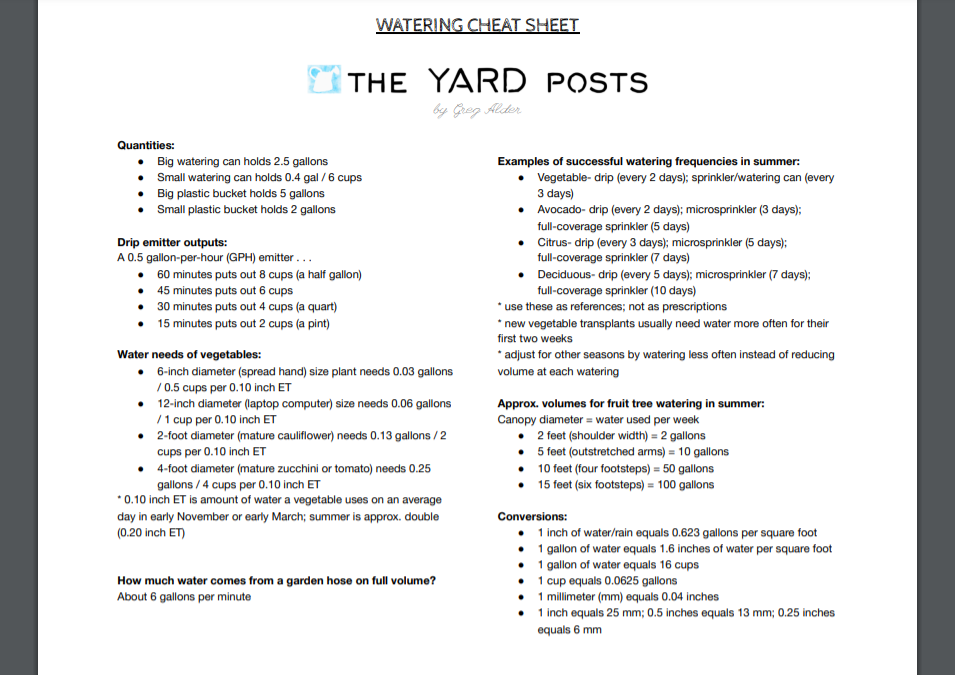I’m always trying to make watering vegetables and fruit trees more turnkey. I don’t want to have to solve math equations every time I water in order to water within the range of effective and efficient, but I also don’t want to be shooting in the dark each time I turn on the sprinklers.
Here I’ve gathered together the most useful rules of thumb, watering volume and frequency examples, and quantity conversions for vegetable and fruit tree growers in Southern California.
I have printed this “Watering Cheat Sheet” and tacked it onto my wall so that I can glance at it before I, say, give the potted mint plant a drink. You might like to print one for yourself.
Also, I’ll be including it in my gardening calendar for 2022 so if you plan to order that you’ll automatically get a copy.
CLICK HERE for a PDF file of the Watering Cheat Sheet that you can freely save to your phone or computer or print.
*Note that “ET” means evapotranspiration, which is the amount of water a plant uses (oversimplified definition). Learn more about ET in my post, “Using the evapotranspiration rate to water your garden better.”
All of my Yard Posts are listed HERE




Very cool! What does “ET” mean?
Good question! Could be extraterrestrial, but isn’t. Let me add a note about evapotranspiration in the post.
At end of article he says ET is “evapotranspiration“.
I’m so puzzled. If drip is the most efficient irrigation, why must it be used more frequently than full coverage sprinklers that (I’m told) lose much of their output to spray drift?
I like this question, Barbara. There are two parts.
One, drip is considered most efficient (potentially) because it nearly eliminates water loss due to evaporation since the water almost entirely goes down into the dirt rather than being exposed to the sun and wind, as it would if it were all over the surface of the dirt like it is with a sprinkler.
Two, you usually have to water more often when you use drip because it doesn’t wet as large of an area of dirt. The plants on drip have smaller stomachs, so to speak, because their roots don’t have as much wet dirt to expand into and drink from. Sprinklers can wet a larger area and therefore give the plant a larger root system. (But drip can also give plants a large area of wet dirt to drink from if many emitters are used.)
Is there a way for me to set up a drip irrigation system for all my fruit trees that is on one-timer and would include an avocado, citrus and stone fruit trees? It looks like they need differing amounts of water so do people set up different timers for different types of trees? Trying to figure out watering always feels so overwhelming to me that in the end I hand water and end up usually under-watering my trees 🙁
Great question, Mika. Yes, you absolutely can water all kinds of fruit trees on one drip system (timer). I mix them up like this sometimes in my yard.
Importantly, you must set the timer to water everything as frequently as the tree that needs it most often (avocado). Do this in combination with using fewer drip emitters (or lower volume emitters) on the trees that need less water (citrus and stone).
When mixing avocado and citrus with stone, it’s best to also use shutoff valves on the drip lines for the stone fruit trees so you don’t waste water on them during winter when they don’t need it.
Hi Greg – Hope all is well. I can’t seem to find where to order your 2022 calendar. Can you please provide a link or details? Thanks!
Hi Cameron,
The calendars are finally ready to order just now.
Here’s the food gardening calendar: https://gregalder.com/yardposts/product/the-yard-posts-food-gardening-calendar-2022/
Here’s the avocado growing calendar: https://gregalder.com/yardposts/product/the-yard-posts-avocado-calendar-2022/